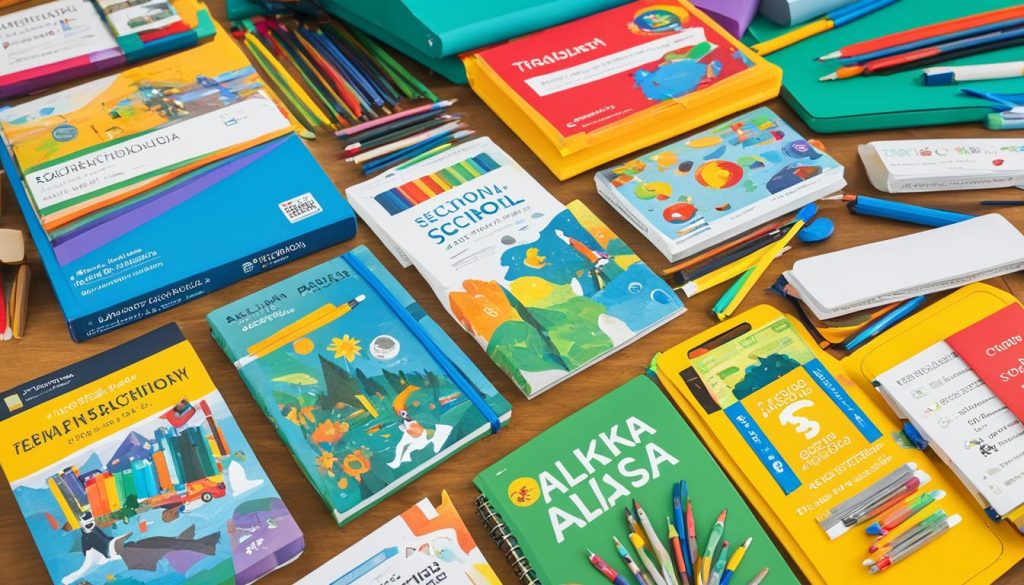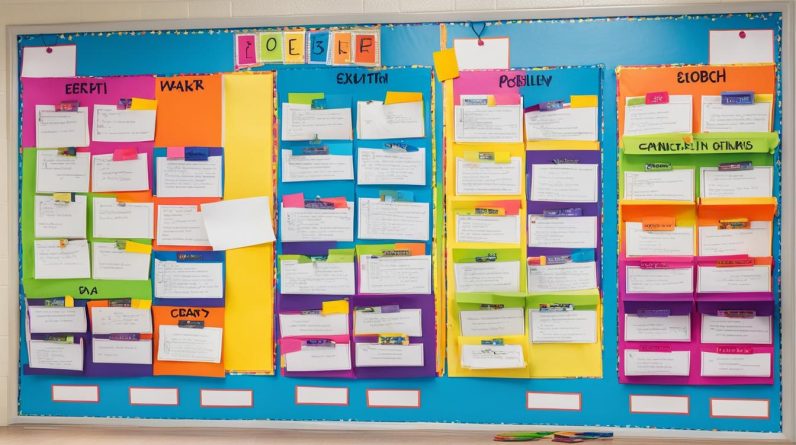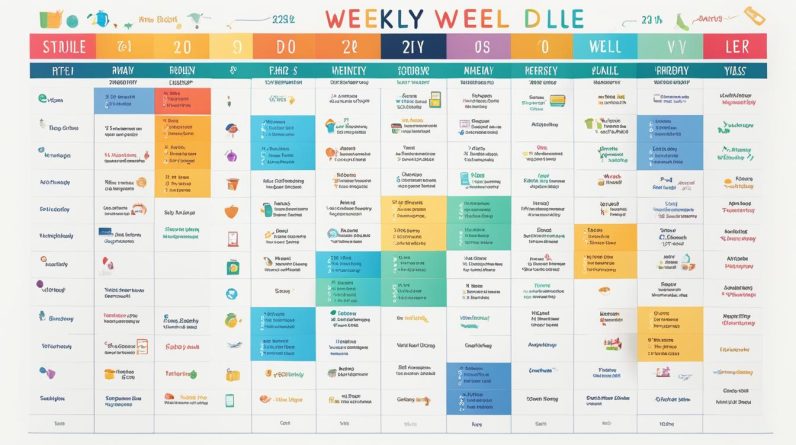Are you considering home education in Alaska? As a parent, you want the best education for your child, and homeschooling offers a unique opportunity to provide a personalized and flexible learning experience. In this comprehensive guide, we will explore everything you need to know about homeschooling in Alaska, from the curriculum to the laws and resources available to support you and your child.
Key Takeaways:
- Alaska homeschooling provides the freedom to tailor your child’s education to their specific needs and interests.
- There are several homeschooling options available in Alaska, including homeschooling under the homeschool statute and homeschooling with school board approval.
- Understanding the homeschooling laws in Alaska, such as recordkeeping requirements and graduation requirements, is crucial for a successful homeschooling journey.
- The Alaska homeschool allotment program offers financial support to homeschooling families to cover educational expenses.
- Utilizing additional resources and support groups can enhance your homeschooling experience and provide a sense of community.
Alaska Homeschool Options
When it comes to homeschooling in Alaska, parents have four different options to choose from. These options allow parents to legally switch from public school to homeschooling while adhering to the state regulations. Let’s explore each of these options in detail:
Homeschooling under the Homeschool Statute
One option is homeschooling under the homeschool statute. This option requires parents to submit a letter of intent to the local school district, outlining their plan to homeschool their child. Parents must also provide academic assessments and keep records of attendance and progress.
Homeschooling with a Private Tutor
Another option is homeschooling with a private tutor. In this scenario, parents hire a private tutor to provide instruction to their child. The tutor must be approved by the state and follow the prescribed curriculum. Parents are responsible for maintaining records and ensuring their child’s educational progress.
Homeschooling with School Board Approval
Parents can also homeschool with school board approval. To pursue this option, parents must submit a written proposal to the local school board outlining their homeschooling plan. The proposal should include the curriculum, assessment methods, and instructional materials. Once approved, parents must comply with the agreed-upon plan and provide regular progress reports.
Homeschooling as a Religious Private School
Lastly, homeschooling can be done under the classification of a religious private school. Parents who choose this option establish their own religious private school and homeschool their child as a part of it. They must meet all the requirements set forth for private schools, including curriculum standards and recordkeeping.
Each homeschooling option in Alaska comes with its own set of requirements and regulations. It’s important for parents to thoroughly understand these options and choose the one that aligns with their educational goals and preferences.
The Alaska Homeschool Allotment
Homeschoolers in Alaska can take advantage of the Alaska homeschool allotment, a valuable resource that helps cover educational expenses. This funding can be used to purchase necessary school materials or be reimbursed for educational purchases already made. The Alaska homeschool allotment provides financial support to families who have chosen to homeschool their children, making it easier to provide a quality education at home.

Educational Expenses Covered by the Alaska Homeschool Allotment
| Expense Category | Description |
|---|---|
| Curriculum Materials | Textbooks, workbooks, online courses, educational software |
| Supplies | Writing tools, art supplies, science equipment, manipulatives |
| Field Trips | Admission fees, transportation costs, educational tours |
| Tutoring Services | Professional tutoring, subject-specific support |
| Specialized Classes | Music lessons, dance classes, foreign language instruction |
| Online Resources | Subscription-based educational websites, virtual learning platforms |
With the Alaska homeschool allotment, families have the freedom to select the educational materials and experiences that best meet their children’s needs. Whether it’s purchasing textbooks and supplies or enrolling in specialized classes, the allotment ensures that homeschooling expenses are manageable and affordable.
Homeschool Recordkeeping in Alaska
Keeping detailed records is crucial for homeschooling parents in Alaska. These records serve multiple purposes, from facilitating the smooth transition of a student back to public school to supporting college applications. Staying organized ensures that you have all the necessary documentation at your fingertips. Here are some essential records to maintain:
1. Standardized Test Results
Regularly assessing your child’s progress with standardized tests provides valuable insights into their academic development. Keep records of test scores and use them as benchmarks to track improvement over time.
2. Curriculum Subjects and Topics Covered
Document the curriculum you use, including the subjects and topics covered. This information demonstrates the breadth and depth of your child’s education. It also helps to pinpoint areas of focus and identify any gaps in learning.
3. Homeschool Transcripts for High Schoolers
If your child is in high school, it’s essential to maintain accurate and comprehensive homeschool transcripts. These transcripts should include course titles, credits earned, grades achieved, and any relevant extracurricular activities or achievements.
4. Samples of Student Work
Keeping samples of your child’s work provides tangible evidence of their academic progress. Include assignments, projects, essays, artwork, or any other relevant materials that showcase their skills and growth.
5. Attendance Records
Accurately recording attendance is a vital component of homeschooling recordkeeping. Documenting regular attendance demonstrates compliance with homeschooling regulations and supports the credibility of your child’s education.
6. Correspondence with School Officials
Save copies of any correspondence exchanged with school officials or district administrators. These communications may include approval letters, registration forms, or any other relevant documents related to your homeschooling journey.
Remember, maintaining detailed and organized records is not only important for compliance but also serves as a valuable resource for evaluating your child’s progress and achievements.
By keeping comprehensive records, you ensure a smoother transition should your child decide to return to public school or pursue higher education. These records provide a record of your child’s academic journey and can help others understand the scope and quality of their homeschool education.
Next, we’ll explore the graduation requirements for homeschoolers in Alaska, ensuring you have the information needed to prepare your child for their academic future.
Homeschool Graduation Requirements in Alaska
While Alaska does not have formal graduation requirements specifically for homeschoolers, it’s important to be aware of the requirements for students in traditional public schools. Public school students in Alaska must complete a minimum of 22.5 credits in various subjects to graduate.
The required credits for high school graduation in Alaska typically include:
- English – 4 credits
- Math – 3 credits
- Science – 3 credits
- Social Studies – 3 credits
- Physical Education – 1.5 credits
- Health – 0.5 credits
- Electives – 7.5 credits
Public school students in Alaska are also required to pass the Alaska High School Graduation Qualifying Exam.
While homeschoolers are not held to the same formal requirements, it can be beneficial to align your homeschool curriculum with these general guidelines for a well-rounded education. Additionally, maintaining thorough homeschool transcripts and records can help showcase your child’s academic achievements and provide documentation for future education or career paths.
| Subject | Credits |
|---|---|
| English | 4 |
| Math | 3 |
| Science | 3 |
| Social Studies | 3 |
| Physical Education | 1.5 |
| Health | 0.5 |
| Electives | 7.5 |

Returning to Public School after Homeschooling
If you have decided to transition your child from homeschooling back to public school, there are a few important steps to take. The process may vary depending on the specific school your child will be enrolling in, so it’s crucial to contact the school as early as possible to understand their requirements and procedures.
One of the key aspects when reintegrating your child into public school is ensuring that their grade placement is appropriate. Some schools may request to review your homeschool portfolio to assess your child’s academic progress and determine their grade level. Maintaining a comprehensive portfolio that showcases your child’s achievements and academic history will greatly facilitate the transition process.
“It’s crucial to contact the school as early as possible to understand their requirements and procedures.”
The school may also have their own assessment methods in place to determine grade placement. This could involve subject-specific evaluations or standardized tests. Understanding these assessment procedures and preparing your child accordingly will help ease the transition and ensure that they are placed in the appropriate grade level.
To facilitate a smooth enrollment process, gather all the necessary documentation, such as your child’s homeschool portfolio, transcripts, and any other records that may be requested by the school. Having these materials organized and readily available will save you time and prevent any unnecessary delays during the enrollment process.
Keep in mind that each school may have different requirements and procedures for enrolling homeschooled students. Being proactive in your communication with the school and providing all requested documentation will help streamline the process and ensure a successful transition from homeschooling to public school.
Homeschool Portfolio Checklist
| Documentation | Description |
|---|---|
| Transcripts | School records that detail the courses and grades your child has completed during homeschooling. Include subject-specific grades, credit hours, and any additional information that showcases your child’s progress. |
| Samples of Work | A collection of your child’s best work, including essays, projects, and assignments. These samples demonstrate their knowledge and abilities in different subjects. |
| Curriculum Used | A list of the curriculum materials and resources you utilized during homeschooling. Include the names of textbooks, online courses, educational software, and any other materials used in each subject area. |
| Standardized Test Results | If your child has taken any standardized tests during homeschooling, include the results to provide an objective measure of their academic achievement. |
| Extracurricular Activities | A record of any extracurricular activities your child participated in during homeschooling, such as community service, sports, music lessons, or clubs. Highlight any leadership roles or notable achievements. |
Preparing a comprehensive homeschool portfolio ensures that you have all the necessary information readily available when transitioning your child back to public school. This portfolio will provide insight into your child’s educational journey and help the school make an informed decision regarding their grade placement.
Additional Resources for Homeschooling in Alaska
When embarking on your homeschooling journey in Alaska, you don’t have to go it alone. There are numerous resources available to support and guide homeschooling families in the state. These resources include homeschool associations, support groups, co-ops, and a variety of curriculum options.
One valuable resource for Alaska homeschoolers is the Alaska Private and Home Educators Association (APHEA). APHEA is a Christian organization that provides workshops, newsletters, and up-to-date information on homeschooling laws in Alaska.
“Homeschooling associations and support groups can provide valuable insights, advice, and connections with other homeschooling families.”
By joining homeschool associations and connecting with support groups, you can tap into a network of experienced homeschoolers who can offer guidance, share curriculum recommendations, and provide social opportunities for your children. These associations and groups often organize field trips, educational activities, and social events, fostering a sense of community among homeschooling families.
For families seeking a cooperative learning experience, homeschool co-ops are an excellent option. These co-ops bring homeschooling families together to share teaching responsibilities, resources, and expertise. By pooling their talents and resources, families can provide their children with a rich and diverse educational experience.
Benefits of Homeschool Associations
Homeschool associations serve as a valuable source of information and support for families navigating the homeschooling journey. They offer resources such as:
- Guidance on homeschooling laws,
- Curriculum recommendations and reviews,
- Workshops on various educational topics,
- Access to local homeschool events and activities,
- Networking opportunities with other homeschooling families.
These associations are often run by experienced homeschooling parents who understand the unique challenges and joys of homeschooling. They can help answer your questions, provide guidance on curriculum choices, and offer advice on how to address challenges that may arise.
Connect with Homeschool Support Groups
Homeschool support groups are another valuable resource for Alaska homeschoolers. These groups bring together like-minded families who are committed to providing their children with a quality education at home. By joining a support group, you can:
- Exchange ideas and experiences with other homeschooling parents,
- Receive support and encouragement during challenging times,
- Participate in co-op classes or extracurricular activities,
- Organize field trips and educational outings,
- Build lasting friendships for both children and parents.
Support groups can also provide valuable information about local resources, including libraries, museums, and educational programs, enhancing your homeschooling experience.
Choosing the Right Curriculum
One of the key considerations for homeschooling parents is choosing the right curriculum for their children. There are numerous curriculum options available for homeschooling families in Alaska, ranging from traditional textbooks to online courses.
When selecting a curriculum, it’s important to consider your child’s learning style, interests, and educational goals. Some families prefer a structured curriculum that provides a step-by-step guide for each subject, while others prefer a more flexible approach that allows for individualized learning.
Additionally, you may want to explore Alaska-specific curriculum options that incorporate local history, geography, and culture into your child’s education.
Remember, finding the right curriculum may involve some trial and error. Don’t be afraid to experiment with different materials and approaches until you find what works best for your child and family.

In summary:
When homeschooling in Alaska, take advantage of the additional resources available to support your homeschooling journey. Homeschool associations, support groups, co-ops, and curriculum options can provide valuable guidance, connections, and educational materials.
By tapping into these resources, you can enhance your homeschooling experience and provide your children with a well-rounded education tailored to their individual needs and interests.
Benefits of Homeschooling in Alaska
Homeschooling in Alaska offers numerous advantages for both parents and students. By choosing to homeschool, you can create a personalized education tailored to your child’s individual needs. This approach allows you to adapt the curriculum and teaching methods to match your child’s learning style, enabling them to thrive academically.
One of the key benefits of homeschooling is the flexibility it provides. You have the freedom to create a schedule that works best for your family. This flexibility allows for more exploration and travel opportunities, as you can plan educational trips and activities based on your child’s interests and the Alaska’s unique natural environment. Homeschooling also allows for a more relaxed pace of learning, giving students the time they need to fully grasp and master concepts.
Individualized instruction is another advantage of homeschooling in Alaska. With one-on-one attention, you can provide your child with the support and guidance they need to excel academically. This personalized approach allows you to tailor the curriculum and teaching methods to suit your child’s strengths and weaknesses. You can also spend more time on subjects that interest them or delve deeper into specific topics, fostering a love for learning and encouraging their intellectual development.
“Homeschooling provides a personalized and flexible education that allows children to learn at their own pace and explore their interests.”
By homeschooling in Alaska, you can create an educational environment that promotes creativity and critical thinking. With the ability to prioritize independent research, hands-on learning experiences, and real-life applications, you can instill a love for learning that goes beyond textbooks and classrooms.
Benefits of Homeschooling in Alaska:
- Personalized education tailored to your child’s needs
- Flexible schedule for exploration and travel opportunities
- Individualized instruction and support
- Promotes creativity and critical thinking
Overall, homeschooling in Alaska offers the advantages of personalized education, a flexible schedule, individualized instruction, and the ability to foster a love for learning. By choosing to homeschool, you can create a unique educational experience that nurtures your child’s academic, personal, and intellectual growth.

Homeschooling vs Public School: Pros and Cons
When it comes to deciding between homeschooling and traditional public school, there are important factors to consider. Both options have their own set of pros and cons, and it’s crucial for parents to assess what will work best for their child’s education.
Pros of Homeschooling
- Individualized attention: Homeschooling allows for personalized instruction, tailored to the specific needs and learning style of the child.
- Curriculum customization: Homeschooling provides the flexibility to choose curriculum and teaching materials that align with the child’s interests, strengths, and weaknesses.
Cons of Homeschooling
- Socialization: Homeschooled children might have fewer opportunities to interact with peers on a regular basis compared to students in public schools.
- Extracurricular activities: Public schools offer a wide range of extracurricular activities such as sports teams, clubs, and events that homeschoolers may not have access to.
“Homeschooling allows for more individualized attention and customization of curriculum, while public schools provide socialization opportunities and access to a wider variety of extracurricular activities.”
Ultimately, the decision between homeschooling and public school depends on the unique needs and circumstances of the child and family. By weighing the benefits and challenges of each option, parents can make an informed choice that best supports their child’s academic achievement and overall well-being.
Homeschooling Tips for Success
Successfully homeschooling in Alaska requires good organization and time management skills. Here are some valuable tips to help you create a thriving homeschooling experience:
- Create a Homeschooling Routine: Establishing a consistent routine is crucial for maintaining structure and productivity. Set clear daily schedules that include designated study times, breaks, and activities to keep your child engaged and focused.
- Set Realistic Goals: Define achievable goals for your child’s education. Break them down into smaller milestones to celebrate progress and keep motivation high. Remember that every child is unique, so tailor your goals to their individual needs and abilities.
- Utilize Online Resources and Support Groups: Take advantage of the wealth of resources available online to enhance your homeschooling curriculum. Use educational websites, virtual field trips, and interactive learning platforms to supplement your lessons. Join homeschool support groups to connect with other parents and share tips, ideas, and experiences.
- Address Homeschooling Challenges: Homeschooling comes with its own set of challenges, such as maintaining discipline, keeping your child motivated, and managing distractions. Be adaptable and open to trying different strategies to overcome these obstacles. Seek guidance from experienced homeschoolers or educational experts if needed.
Remember, homeschooling provides the flexibility to tailor your child’s education to their needs and interests. Embrace the journey and enjoy the unique rewards it brings!
By implementing these homeschooling tips, you can create a well-organized, effective learning environment for your child in Alaska.
| Benefits | Challenges |
|---|---|
| 1. Personalized education tailored to your child’s needs. | 1. Maintaining discipline and motivation. |
| 2. Flexibility in scheduling and curriculum. | 2. Balancing multiple responsibilities. |
| 3. Individualized attention and support. | 3. Limited access to extracurricular activities. |
| 4. Opportunity for more exploration and travel. | 4. Managing distractions and interruptions. |
Homeschooling Tips in Action:
Meet Sarah, a homeschooling parent in Alaska. She recognizes the importance of homeschool organization and time management in creating a successful homeschooling routine for her three children. Sarah follows a structured schedule, starting each day with a morning meeting to set goals and expectations. She utilizes online resources, such as interactive math programs and virtual science experiments, to supplement her curriculum. Sarah actively participates in a local homeschool support group, attending regular meetings and sharing ideas with fellow homeschoolers. Whenever challenges arise, she remains open-minded, seeking advice and implementing new strategies to overcome obstacles. By adopting these homeschooling tips, Sarah has created a positive and rewarding homeschooling experience for her family.
Online Homeschooling Programs in Alaska
When it comes to homeschooling in Alaska, online programs offer a convenient and flexible education option for families. These programs provide a comprehensive curriculum, interactive lessons, and personalized instruction, all from the comfort of your own home.
One of the major advantages of online homeschooling programs is the wide range of courses available. Whether your child needs to brush up on math skills, explore science concepts, or dive into history, these programs offer a diverse selection of subjects to suit their interests and learning needs.
Additionally, online homeschooling programs prioritize interactive learning experiences. Through multimedia presentations, virtual labs, and engaging activities, children can actively participate in their education and develop a deeper understanding of the material.
For families in rural areas of Alaska, online homeschooling programs can be particularly valuable. These programs eliminate the need for long commutes to physical schools and allow students to access quality education from anywhere with an internet connection.
Furthermore, virtual learning through online homeschooling programs promotes distance learning, enabling students to work at their own pace and set their own schedules. This flexibility is especially beneficial for students who have other commitments or prefer a non-traditional school day structure.
In conclusion, online homeschooling programs in Alaska provide an excellent option for families seeking a comprehensive, flexible, and virtual learning experience. With a robust curriculum, interactive lessons, and the convenience of remote education, these programs empower parents to create a rewarding homeschooling journey for their children.
Conclusion
In summary, homeschooling in Alaska offers parents a viable educational option that provides flexibility, customization, and access to a wealth of supportive resources. By familiarizing themselves with homeschooling laws, utilizing available resources, and implementing effective strategies, parents can create a successful homeschooling experience for their children.
Whether families choose to homeschool for a few years or throughout their child’s education, the benefits of homeschooling in Alaska are numerous. Parents can tailor the curriculum to their child’s unique needs and learning style, enabling them to receive a personalized education. Additionally, the flexibility of homeschooling allows for a customized schedule, providing opportunities for exploration, travel, and extracurricular activities.
Furthermore, homeschooling in Alaska is supported by various resources and organizations. Homeschool associations, support groups, and co-ops offer workshops, newsletters, and valuable information on homeschooling laws and curriculum options. These resources enable parents to connect with like-minded individuals and find the support they need to ensure their child’s homeschooling journey is a success.
In conclusion, homeschooling empowers parents to take an active role in their child’s education and provides a unique and enriching learning experience. With dedication and careful planning, Alaska homeschooling can foster a love of learning and set the foundation for academic success.
FAQ
What are the options for homeschooling in Alaska?
Alaska offers four routes for homeschooling parents to legally switch from public school to homeschooling. These options include homeschooling under the homeschool statute, homeschooling with a private tutor, homeschooling with school board approval, and homeschooling as a religious private school. Each option has its own requirements and regulations that parents need to be aware of.
What is the Alaska homeschool allotment program?
The Alaska homeschool allotment is a fund that can be used to cover educational expenses for homeschoolers. This fund can be used to purchase school materials or can be reimbursed for educational purchases already made. The Alaska homeschool allotment provides financial support to families who choose to homeschool their children.
What records do I need to keep as a homeschooling parent in Alaska?
Keeping detailed records is important for homeschooling parents in Alaska. Examples of records to keep include standardized test results, curriculum subjects and topics covered, homeschool transcripts for high schoolers, samples of student work, attendance records, and correspondence with school officials.
Are there graduation requirements for homeschoolers in Alaska?
While Alaska has no formal graduation requirements for homeschoolers, it’s helpful to understand the requirements for traditional public school students. Public school students in Alaska must complete a minimum of 22.5 credits to graduate, including credits in English, math, science, social studies, physical education, health, and electives. Public school students must also pass the Alaska High School Graduation Qualifying Exam.
How can I transition my child from homeschooling back to public school in Alaska?
If you decide to transition your child from homeschooling back to public school, it’s important to contact the public or private school your child will be enrolling in. They may request to view your homeschool portfolio to determine grade placement or may have their own assessment methods. Each school may have different requirements and procedures for enrolling homeschooled students.
What additional resources are available for homeschooling families in Alaska?
Homeschooling families in Alaska have access to homeschool associations, support groups, co-ops, and curriculum options. The Alaska Private and Home Educators Association (APHEA) is a Christian organization that offers workshops, newsletters, and updated information on homeschooling laws. It’s important to explore these resources to find the support and curriculum options that best fit your homeschooling needs.
What are the benefits of homeschooling in Alaska?
Homeschooling in Alaska offers personalized education tailored to the child’s individual needs, a flexible schedule that allows for more exploration and travel opportunities, and the ability to provide individualized instruction and support.
What are the pros and cons of homeschooling in Alaska compared to public school?
Homeschooling allows for more individualized attention and customization of curriculum, while public schools provide socialization opportunities and access to a wider variety of extracurricular activities. It’s important for parents to weigh these factors when deciding which educational option is best for their child.
What tips can help me succeed in homeschooling in Alaska?
Successfully homeschooling in Alaska requires good organization and time management skills. Creating a homeschooling routine, setting realistic goals, utilizing online resources and support groups, and addressing any challenges that arise are all important strategies for a successful homeschooling experience.
Are there online homeschooling programs available in Alaska?
Yes, online homeschooling programs can provide a comprehensive and flexible education option for families in Alaska. These programs offer a wide range of courses, interactive lessons, and personalized instruction. They can be particularly beneficial for families in rural areas or those seeking a more virtual learning environment.






